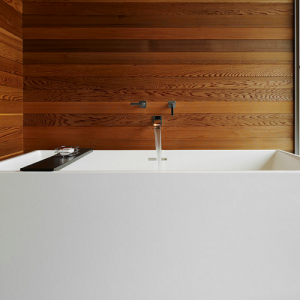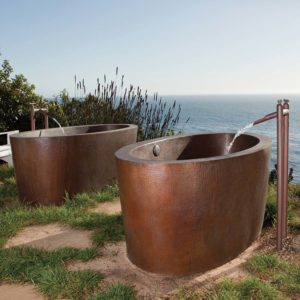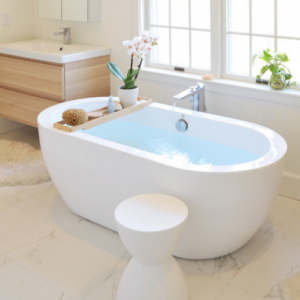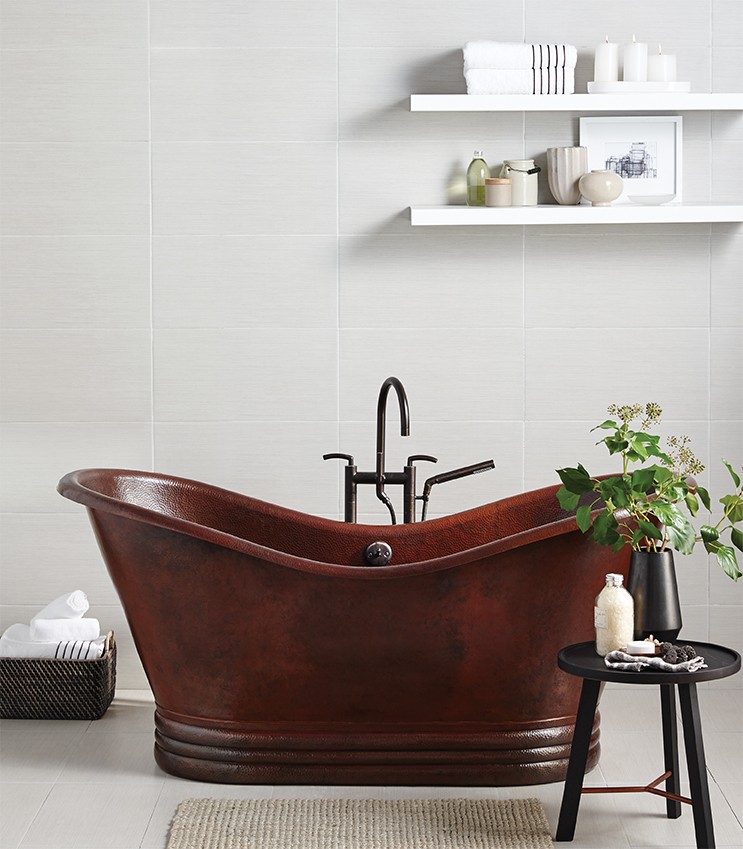Selecting a Tub Filler
Expert advice on tub fillers from kitchen & bath design pros
Now that you’ve settled on a dreamy bathtub to sink into, you will want to know how best to fill it with water. Look no further; this compendium of advice from three top kitchen and bath design experts will tell you everything you need to know to find the right tub faucet for every style and space.
Our panel of experts includes Alese Campbell, Corporate Showroom Manager for Crawford Supply in the Chicago area; Mindy Sevinor, Showroom Brand Manager for Designer Bath in Beverly, MA; and Mitsi Schwertner, Showroom Manager at Hajoca Corporation in Greensboro, N.C.
Let’s talk options. What are the styles of tub fillers available?

Wave Wall Mount Tub Filler by Rohl with Cube Bathtub by Wetstyle. Bathroom by AT6 Architecture.
Campbell: There are three different styles of tub fillers: wall-mount, deck-mount and floor-mount. The wall-mount mounts to the wall, the deck-mount mounts to the deck of the tub, and the floor-mount is mounted outside of the tub on the floor. Choosing which to install really depends on the tub design and your personal use of the tub. The function of each is the same. One does not perform better than the other.
Sevinor: Tub fillers vary in both aesthetic style and configuration based on the tub application. Deck-mounted tub fillers mount on a flat surface area, whether it be the deck of the tub or a box that has been built. There are also wall-mounted tub fillers that mount on the wall and freestanding tub fillers that stand independently. These are more common, and ideal when there is not a flat mountable area to mount a faucet. They are typically more expensive than deck-mounted or wall-mounted tub fillers, due to the fact that there is much more raw brass and finish material required.
Do you have a recommendation for which would be the best faucet to use with a freestanding tub?

WaterBridge Tub Filler by Sonoma Forge with Aspen copper bathtub in Antique by Native Trails.
Campbell: We see all three types of fillers with freestanding tubs. Probably the cleanest look is the floor mount. This will keep the design of your freestanding tub clean and clutter-free.
Sevinor: The style of the filler is contingent upon the type of tub and installation restrictions. More often than not, freestanding tub fillers seem to be the client’s preference with freestanding tubs.
Schwertner: It depends on the tub—new tub styles are now available with a deck-mount faucet option, which is more cost-effective, as there’s less brass to plate.
What’s popular right now in finishes? Do you have any advice for selecting a finish?
Campbell: We see all finishes sold for tub fillers, including polished chrome, brushed nickel and oil-rubbed bronze. Today, the most common finish seems to be a polished chrome or a nickel finish, though gold tones are definitely making a comeback. The finish is a personal choice. I’ve heard people say that a brushed finish doesn’t show water spots as much, but if you just use a polishing cloth after use, this really isn’t an issue. The finish is just another statement reflecting the style of your home.

Tub filler by Toto with Soho bathtub by Wyndham. Bathroom by Herbert Design Build.
Sevinor: In the Northeast the most common finishes are polished chrome, brushed nickel and polished nickel. However, brass is back, and other specialty finishes like matte black are increasing in popularity. Continuity is best. Make your finish reciprocal of your other fixtures in your space.
Schwertner: Polished chrome, satin nickel, polished nickel and now more oil-rubbed bronze—all still highly requested. Tub filler design and finish tends to match, and if not match, flow in style—not every option for a sink faucet has matching tub filler.
Do you have any tips when it comes to installation?
Sevinor: If you are using a freestanding tub filler, sometimes they offer stabilizing brackets. If they sell them it’s for a reason! This makes the tub filler more stable and sturdy during water delivery.
Schwertner: Consider the height and reach of the filler. Tub heights vary; be sure your faucet will work.
What are your favorite tub filler manufacturers? Are there any particular faucets that you specifically recommend?
Campbell: Kohler, Hansgrohe, Grohe, California Faucets, Newport Brass, and Rohl are some of my favorites.
Sevinor: Sigma and Franz Viegener; we can’t wait for the Franz Viegener Industrial Chic freestanding tub filler coming soon!
Schwertner: California Faucets, Barclay, Delta, Brizo, Rohl, Hansgrohe, Watermark, Newport Brass—I use and recommend all, all based on customer needs—finish, style, lead time, cost … plenty of options!

Asilomar Contemporary Floor Mount Tub Filler by California Faucets with Avalon 72 concrete bathtub in Slate.
What are your final words of advice?
Campbell: Just be sure to buy a quality filler from a quality dealer.
Sevinor: There are a few key components to consider. The first is the gallons per minute. Will the tub fill produce enough water in a timely fashion to fill the size of the tub selected? The second is the spout length. You want the water to fall appropriately in the tub close to the waste, but you also don’t want the reach to end in the middle of the tub. Who wants to dodge a tub spout? That brings up another critical point—placement. If it’s a two-person tub, an end placement for the tub fill would be less than ideal and uncomfortable. For a single bather tub there is more flexibility with placement.
Schwertner: Most all tub fillers offer a hand spray. A hand shower is great for rinsing the tub after bathing and for cleaning.
Want more about the bath?
Discover the first-ever NativeStone® bathtub, and explore Native Trails’ full collection of concrete and copper bathtubs.
Here’s a celebration of a long hot bath, and a look at copper tubs throughout history.

